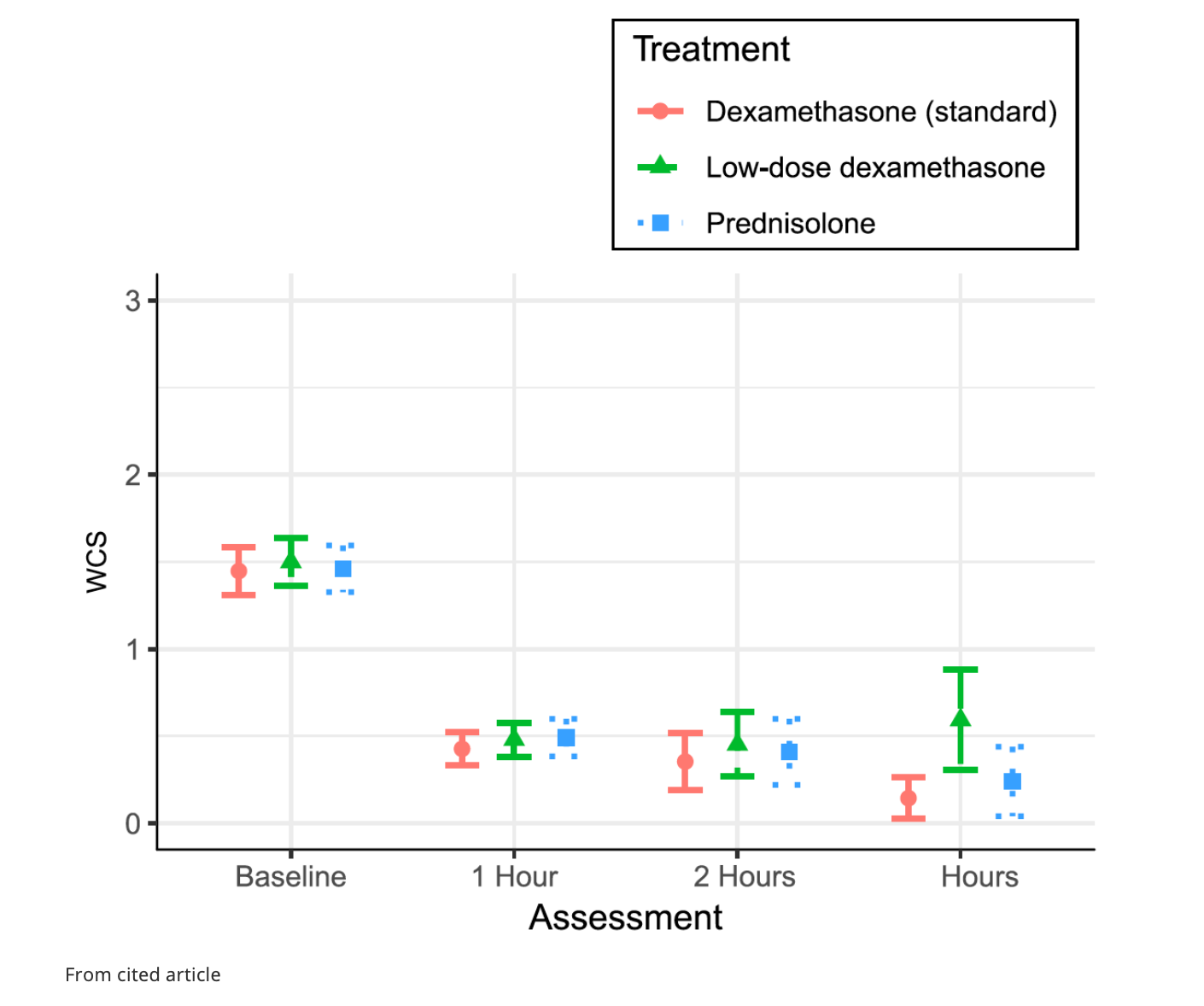We always work hard, but we may not have time to read through a bunch of journals. It’s time to learn smarter.
Originally published at JournalFeed, a site that provides daily or weekly literature updates.
Follow Dr. Clay Smith at @spoonfedEM, and sign up for email updates here.
#1: Ibuprofen – 400mg, 600mg, or 800mg?
Spoon Feed
For short term relief of acute pain in the ED, 400 mg of oral ibuprofen offers a similar decrease in pain score compared to both 600 mg and 800 mg of ibuprofen.
Why does this matter?
Ibuprofen is one of the most frequently used oral analgesics in the ED and it is often given in higher doses than its analgesic ceiling with the assumption that it may have a greater effect on pain.
More ibuprofen may not be better
This was a randomized, double-blind study in which researchers enrolled 225 adult ED patients with acutely painful conditions and randomized them to receive 3 different doses of ibuprofen: 400, 600, and 800 mg. Pain scores were obtained at baseline and after 60 minutes following ibuprofen administration on a standard 0 to 10 pain scale. Reductions in pain score from baseline were similar in each group and there were no clinically meaningful differences in mean pain scores between the 3 groups at 60 minutes. Mean pain scores in the 400, 600, and 800 mg ibuprofen groups changed from 6.48 to 4.36, 6.35 to 4.5, and 6.46 to 4.5 after 60 minutes, respectively. No adverse effects were reported, although patients were only followed for 60 minutes. This a good reminder of ibuprofen’s analgesic ceiling for short term pain relief.
Source
Comparison of Oral Ibuprofen at Three Single-Dose Regimens for Treating Acute Pain in the Emergency Department: A Randomized Controlled Trial. Ann Emerg Med. 2019 Aug 2. pii: S0196-0644(19)30449-4. doi: 10.1016/j.annemergmed.2019.05.037. [Epub ahead of print]
Open in Read by QxMD
#2: Steroids for Croup RCT – Dexamethasone or Prednisolone?
Spoon Feed
Low dose dexamethasone 0.15 mg/kg and prednisolone 1 mg/kg had similar efficacy to the standard dexamethasone 0.6 mg/kg for treatment of croup. In addition, length of stay, use of nebulized epinephrine, recurrent presentations, and adverse events were similar for all steroids used for croup treatment.
Why does this matter?
Multiple studies have shown steroids significantly decrease the rate of hospital admission, length of stay, return visits, endotracheal intubation, and admission to ICUs in patients with croup. Oral dexamethasone 0.6 mg/kg is the traditional steroid used for croup management. However, are other steroid formulations such as low dose dexamethasone or prednisolone similarly effectively?
Croup on steroids…
This was a prospective, double blind, randomized controlled trial at 2 hospitals in Australia with 1,252 patients comparing the standard 0.6 mg/kg oral dexamethasone to lower-dose dexamethasone (0.15 mg/kg) and prednisolone (1 mg/kg) for croup management. The primary endpoints were croup severity measurements (using the Westley Croup Score – WCS) from baseline to 1, 2, and 3 hours after treatment as well as the rate of unscheduled medical re-attendance in the week after initial treatment.
There was no statistically significant difference between the groups for croup severity score at the 1 and 2 hour assessments after steroid administration. The vast majority (92%) of patients were successfully treated and discharged within 2 hours, improving from an average WCS of ∼1.5 to ∼0.5 over the first hour after treatment, with no differences between the 3 groups. The WCS was 0.23 higher at 3 hours for the 0.15 mg/kg dexamethasone group compared to the 0.6 mg/kg dexamethasone group which was statistically significant (P=.04) but within the non-inferiority margin. See Figure below from the article for reference.

Re-attendance rates for medical care were modest at 17.8% (dexamethasone), 19.5% (low-dose dexamethasone), and 21.7% (prednisolone), and similarly, repeat ED visit rates were low at 5.9% (dexamethasone), 8.8% (low-dose dexamethasone), and 7.5% (prednisolone), with no statistical difference between treatment groups.
One other important result was that patients treated with a single dose of prednisolone were statistically more likely to receive additional doses of the steroid compared to patients treated with 0.6 mg/kg dexamethasone (18.9% vs 11.3%, P = .02), which is likely related to prednisolone’s shorter duration of action. The length of stay, use of nebulized epinephrine, and adverse events were similar for all steroids used for croup treatment.
These results suggest low dose dexamethasone 0.15 mg/kg and prednisolone 1 mg/kg are safe and effective alternatives to dexamethasone 0.6 mg/kg for the treatment of croup. However, further investigation is likely needed before dexamethasone 0.6 mg/kg is dethroned as the gold standard for croup management.
Source
Prednisolone Versus Dexamethasone for Croup: a Randomized Controlled Trial. Pediatrics. 2019 Aug 15. pii: e20183772. doi: 10.1542/peds.2018-3772. [Epub ahead of print]
Open in Read by QxMD
#3: VAPI – Vaping Associated Pulmonary Illness – What You Need to Know
Spoon Feed
Vaping has been associated with severe acute lung injury (ALI) in over 500 young people, and seven have died to date. Here is what you need to know.
Why does this matter?
We will be on the front lines to encounter this illness. If you see a young person with seemingly unexplained ALI, this needs to be on your differential diagnosis. Here’s how it presents, what to ask, and what to do.
Vaporizing and inhaling an oily liquid is bad? Go figure…
This was a case series of 53 people, largely men, who had used a vaping product and developed severe pulmonary and constitutional symptoms with bilateral infiltrates on CXR. One-third required intubation; one died. They couldn’t pinpoint a specific device or product that was the culprit, though 84% with VAPI had used THC products in the device.
What to Know/What to Do: It is important to ask about vaping in the past 90 days in any young person with unexplained respiratory symptoms, ALI pattern, and bilateral infiltrates on CXR. They often (>80%) have vomiting or diarrhea as well. Ask what device and product they used and whether or not it contained THC. Ask if they have any of the product left over for testing. Corticosteroids have helped in many cases.
Since this case series, the CDC has gathered >530 cases and 7 deaths. It appears to be due to a lipoid pneumonia, and vitamin E acetate has been present in many of the samples, often associated with use of THC products in the vaping device.
Another Spoonful
-
The American Thoracic Society has issued this guidance. It has some great CT images showing the acute lung injury.
-
This is the CDC homepage for VAPI. This is critical for ongoing updates.
-
This is an FDA public health notification.
Source
Pulmonary Illness Related to E-Cigarette Use in Illinois and Wisconsin – Preliminary Report. N Engl J Med. 2019 Sep 6. doi: 10.1056/NEJMoa1911614. [Epub ahead of print]
Open in Read by QxMD








